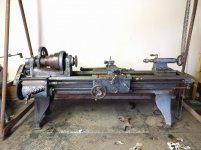First off, please excuse any faux pas I may make here, I'm new here and while I'm definitely not a machinist, I have an interest and a desire to learn so please bear with me!
I just recently picked up an old Hendey 18 x 8 cone head lathe that I'm trying to learn more about, from what I understand it's the older pattern without the reinforcing bar across the top of the head stock.
What I've been looking for is a an operators manual, or something similar, that might show how to properly maintain and operate the lathe, my experience so far has been on much smaller machines.
Here's a picture of the machine to get an overall idea of what it is:
![IMG_20161106_200002[1].jpg IMG_20161106_200002[1].jpg](https://www.practicalmachinist.com/forum/data/attachments/154/154895-43efe5c73cf5f1a6b0e07d726c26bdc5.jpg)
I haven't been able to locate a serial number on it so far, but it's still pretty grimy, so it may be hiding at the moment.
So far the only deficiency I've found with it, aside from the obvious broken gate on the gearbox, is that the rack under the apron is damaged about halfway through and it drops out of engagement with the hand wheel.
Any how, if you folks that are more familiar with the Hendey lathes could drop me some hints, tips, suggestions and so forth it would be greatly appreciated!
I just recently picked up an old Hendey 18 x 8 cone head lathe that I'm trying to learn more about, from what I understand it's the older pattern without the reinforcing bar across the top of the head stock.
What I've been looking for is a an operators manual, or something similar, that might show how to properly maintain and operate the lathe, my experience so far has been on much smaller machines.
Here's a picture of the machine to get an overall idea of what it is:
![IMG_20161106_200002[1].jpg IMG_20161106_200002[1].jpg](https://www.practicalmachinist.com/forum/data/attachments/154/154895-43efe5c73cf5f1a6b0e07d726c26bdc5.jpg)
I haven't been able to locate a serial number on it so far, but it's still pretty grimy, so it may be hiding at the moment.
So far the only deficiency I've found with it, aside from the obvious broken gate on the gearbox, is that the rack under the apron is damaged about halfway through and it drops out of engagement with the hand wheel.
Any how, if you folks that are more familiar with the Hendey lathes could drop me some hints, tips, suggestions and so forth it would be greatly appreciated!


